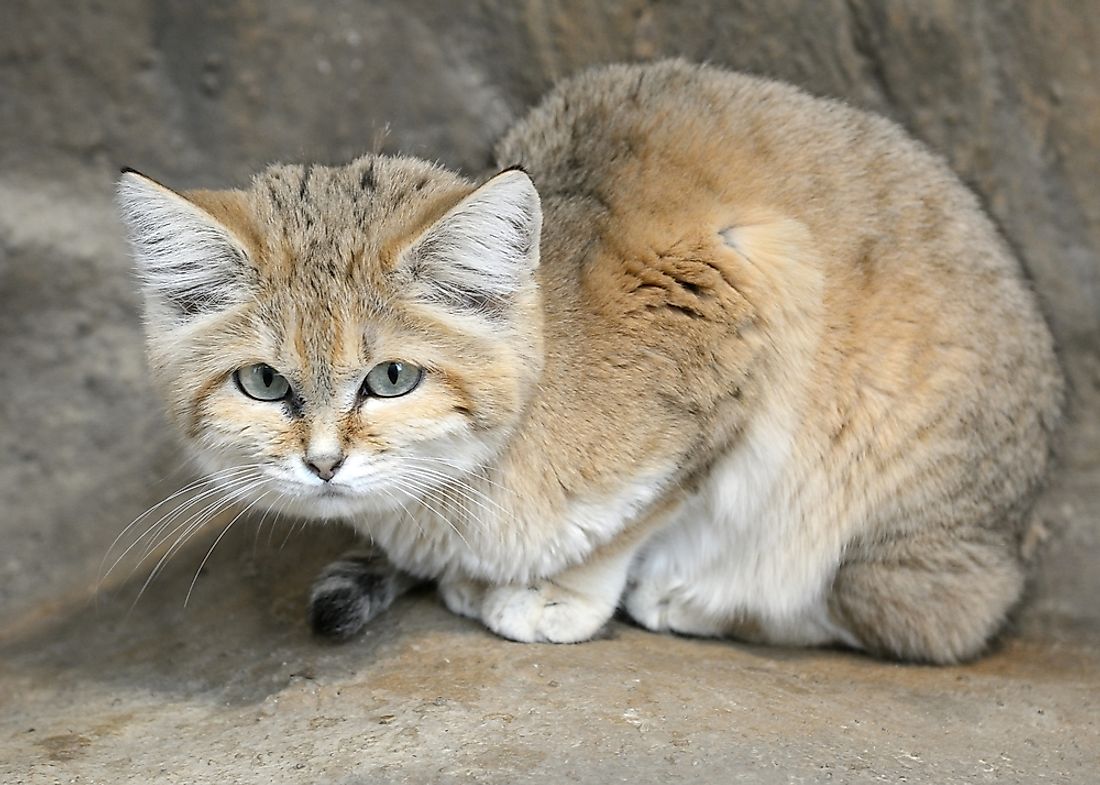What Animals Live In The United Arab Emirates?

The United Arab Emirates (UAE), a Western Asian country in the Arabian Peninsula, has a long coastline on the Persian Gulf and vast stretches of sandy desert covering most of its landscape. Thus, the flora and fauna found in the UAE are well-adapted to the desert environment. The indigenous fauna of the country is also close to extinction due to intensive hunting, capture for the pet trade, and habitat loss. Some of the most notable animals found in the UAE have been mentioned below.
7. Arabian Tahr

Arabitragus jayakari is an Endangered species found only in the mountains of UAE and northern Oman where these animals preferably inhabit the north-facing slopes at elevations ranging from 1,000 to 1,800 m. It is estimated that the total population of this species is only around 5,000. The Arabian tahr is the smallest species of tahr. It has a stocky build and backward-arching horns. The coat is reddish-brown in color and a dark stripe runs down its back. Male tahrs have the most impressive manes. These animals are browsers that feed on grass, leaves, fruits, and shrubs.
6. Arabian Leopard

The Panthera pardus nimr is a critically endangered leopard subspecies that is found in the Arabian Peninsula. The population of this leopard is extremely small and severely fragmented. It is estimated that there are only around 50 mature individuals of this species in the wild. These animals live in the hilly steppes and mountains of their range. The Arabian leopard was first sighted in the UAE in 1949. The exact status of this animal in the country remains unclear. It is either extinct or very rare in the country. In the past, sightings of this species were reported in Wadi Wurayah, Al Hajar Mountains, and Jebel Hafeet. Arabian leopards are predominantly nocturnal species that feed on Arabian gazelle, Cape hare, rock hyrax, rodents, etc.
5. Arabian Oryx

The Oryx leucoryx, also called the white oryx, is an antelope living in the wilds of the UAE and other parts of the Arabian Peninsula where they are found in the desert and steppe areas. These animals possess a distinct shoulder bump and have straight horns and tufted tails. The coat color is almost luminous white while the undersides and legs are brown. Some black stripes are present on the head. They feed primarily on grasses but also consume other plant matter like herbs, roots, fruits, buds, etc. They can survive for several weeks without water. Although the species was declared extinct in the wild in the 1970s, successful captive breeding programs followed by the reintroduction of the species into the wild allowed it to recover.
4. Arabian Sand Gazelle

Gazella marica is a gazelle species found in the Arabian and Syrian deserts. Today, small wild populations of this gazelle are found in the UAE, Saudi Arabia, Oman, Turkey, and a few other countries. The total population of this species is estimated to be less than 1,000. However, a large captive population of this species also exists in the region. The Arabian sand gazelle avoids steep, rocky areas and prefers desert habitat including sand dunes and areas of gravel and sand and also coastal flats. Today, the species is threatened by uncontrolled hunting and habitat loss due to overgrazing.
3. Striped Hyena

The Hyaena hyaena is a hyena species that is native to the Middle East, North and East Africa, Central Asia, and the Indian subcontinent. The global population of this species is estimated to be less than 10,000 mature individuals. Hence, IUCN has listed this species as near-threatened. It is the smallest species of the true hyenas. It is primarily a scavenger but also occasionally hunts for prey. It is a nocturnal animal that returns to its lair prior to sunrise. Another interesting behavior exhibited by this animal is feigning death when under threat. The striped hyena is a monogamous animal where both females and males participate in raising the cubs. Middle Eastern folklore prominently features the striped hyena. Decreasing prey base and incidental or deliberate persecution are the biggest threats to this species.
2. Sand Cat

The Felis margarita is the only cat species that lives in the true desert. It is found in the deserts of the Middle East, Central Asia, and North Africa. In 2002, the species was listed as Near Threatened due to declining population but was downlisted to least concern in 2016. The sand cat is well adapted to live in an extreme desert environment. It has long hairs covering the soles of the feet. It has a pale, sandy-colored fur with or without spots and stripes. It is small in size and has long ears. This species is found in both stony and sandy deserts where it preys on small rodents and reptiles. Like most cats, sand cats are also solitary in nature. Habitat degradation, a decline in prey base, desertification, retaliation killing, and trapping are the biggest threats to the sand cats in their desert environment.
1. Arabian Wolf

The Canis lupus arabs is a gray wolf subspecies that is native to the Arabian Peninsula. It is the smallest species of wolf and is adapted to live in the desert. It has large ears compared to body size, a feature that helps disperse body heat. The Arabian wolf is an omnivorous animal that hunts for prey in small groups of two to four and also feeds on carrion and garbage. Hares, rodents, cats, small ungulates constitute the prey base of these animals. Since these wolves are known to attack domestic animals, they are often killed by the farmers and Bedouins to protect their prey. In the UAE, captive breeding programs have been launched to protect these animals. In some parts of its range, the Arabian wolf is a protected species.











